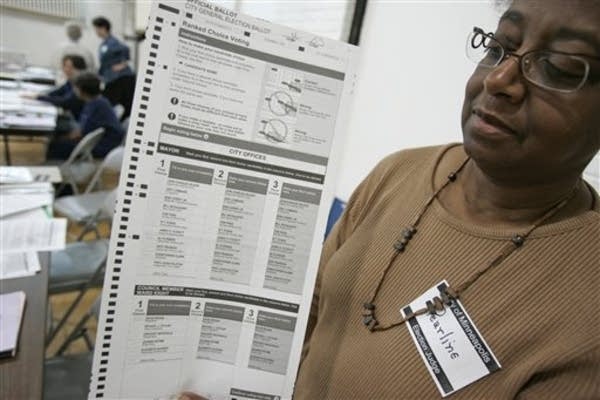IRV poses few problems for Minneapolis voters
Go Deeper.
Create an account or log in to save stories.
Like this?
Thanks for liking this story! We have added it to a list of your favorite stories.

Minneapolis elections officials say the city's first election using instant runoff voting has gone smoothly, but voters may be limiting their own power because they're not using all their choices.
Instant runoff voting is also called ranked choice voting because it lets voters designate a first, second and third choice candidate for every office on the ballot. The system, which was approved by the city council, eliminates the need for a primary election.
Minnesota Public Radio News talked with dozens of voters at polling sites around Minneapolis today. And while the majority said they liked having the option of ranking multiple candidates, it's an option most of them didn't use.
"I didn't really have second choices today," said Ed Fessler, a tax preparer who lives in the Corcoran neighborhood.
Turn Up Your Support
MPR News helps you turn down the noise and build shared understanding. Turn up your support for this public resource and keep trusted journalism accessible to all.
"I didn't recognize enough of the more minor candidates," said Jonathan Neville, a graduate student who lives near Loring Park.
Paralegal Eric Lindberg had the same reason. "I didn't want to put a vote in for someone I didn't feel comfortable with," he said.
"There were times that I would have," social worker Britta Anderson said. "but today I was just pretty set on who probably is going to win and that's who I wanted to vote for, so I didn't take advantage of that."
Under instant runoff voting rules, your ballot still counts, even if you don't pick second and third choice candidates. But depending on how the election turns out, it might not count as much as the ballot of someone who did use all their choices.
Instant runoff voting ballots are counted in rounds. If no candidate has a majority of the first choice votes, then the candidate in last place is eliminated. If you voted for that candidate, your vote moves to your second choice. But if you don't have a second choice, then your vote stops counting in that race.
That's why North Minneapolis voter Mitch Schiebe made sure to rank three candidates in every race.
"I heard on the TV they were saying if you don't do all three they might throw them away or something like that. But inside they were saying that wasn't the case," he said. "But I thought 'why take the chance?'"
Minneapolis elections director Pat O'Connor says he'd rather see people just vote for one, rather than feel pressured to use up all their choices.
"I wouldn't want people to think that they had to do a second, third, just because it's there," he said.
From O'Connor's perspective, the main benefit of instant runoff voting is it allows people who want to support minor-party candidates to vote their conscience. Those voters can use their second choice vote to support a more viable candidate.
O'Connor says if voters aren't ranking multiple candidates, it's probably because they're not worried their first choice candidate is going to lose.
"I'm not sure we have many of those kind of contests this time around," he said.
The lack of a hotly contested mayor's race may be one reason voter turnout has been pretty light. O'Connor says he would have preferred a more competitive election so voters could get a better feel for how instant runoff voting works.
But election judge Wayland Noland says the low turnout may be a blessing. He'd been skeptical about the new system, worried there'd be crowds of confused voters. But by noon only 60 people had shown up to vote at Noland's precinct, only a few of whom were confused.
"This is a test and so far it's passing," he said.
Dear reader,
Political debates with family or friends can get heated. But what if there was a way to handle them better?
You can learn how to have civil political conversations with our new e-book!
Download our free e-book, Talking Sense: Have Hard Political Conversations, Better, and learn how to talk without the tension.




